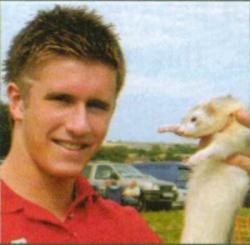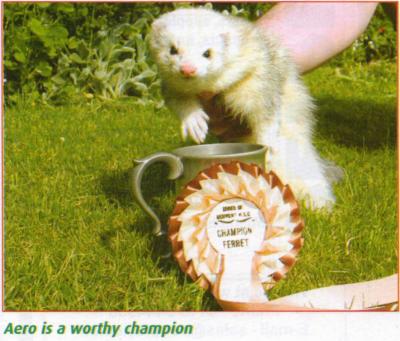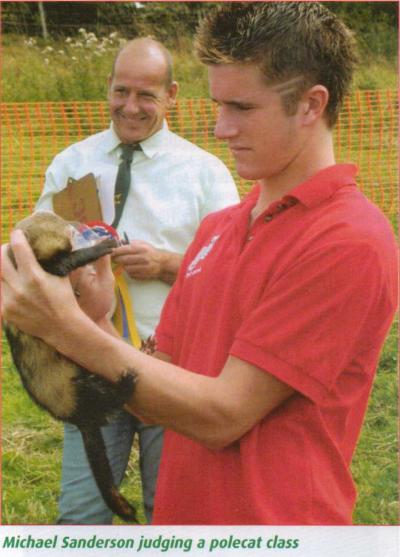Choosing the Best - Top Judging Tips
 MICHAEL SANDERSON continues his in-depth look at the world of ferret showing with advice on how to become a judge.
MICHAEL SANDERSON continues his in-depth look at the world of ferret showing with advice on how to become a judge.
Anyone thinking of taking up judging must first prove themselves to be a success at shows. This may take a while, but with exceptional achievement you could start judging within a couple of years. It depends on how quickly you gather the necessary knowledge. I started to judge after only a year.
Show organisers are looking for consistent winners. This proves that you know what the judge is looking for. Join a ferret club and ask if you can mark for a judge at a show. Watch carefully how points are awarded. Ask them to take you through the criteria by which a ferret is judged.
You must be totally confident handling other people's ferrets. Some ferrets will bite you! This must not be greeted with panic! A judge must be able to stay calm and know how to detach the ferret safely. Hysteria will only worsen the situation and the ferret will not let go. Ferrets that bite you should be disqualified immediately. Make some allowances in the kit class as kits often just play bite but do not accept any behaviour that is vicious towards you or the steward. You must also be totally impartial.
The tolerance of the ferret when being judged will be greatly dependent on the way in which you handle it.
 You must be confident but gentle. You must also wash your hands after every ferret, especially when moving on to the hob class after judging jills, particularly in summer when entire hobs are in season.
You must be confident but gentle. You must also wash your hands after every ferret, especially when moving on to the hob class after judging jills, particularly in summer when entire hobs are in season.
It is often helpful to know the ferret's age. You can instruct the steward to ask as he or she picks up the ferret from the owner.
Here is a list of all the main features you should be looking for when judging:
PROPORTION - The ferret's body, head and tail should be in proportion with one another. For example, a ferret with a small head and large overweight body would not score highly.
HEAD - Hobs should have a broad face and jills a more thin, tapered, face. The face should not be too pointy and 'mouse like'. When judging polecats, the nose should be totally black and the black mask should not join with black hair on the forehead, there should be a visible lighter band between the two. Sandy ferrets should not have a mask.
EYES - Eyes should be large and bright. A pure bred sandy should have ruby, not black, eyes. There should be no discharge from the eye or tear stains around the outside, although be aware that some sandy ferrets have markings around the outside of the eye that can be mistaken for tear stains. These markings are like glasses around the eyes.
TEETH - Teeth should be white and complete and the upper and lower teeth should evenly meet one another, with the jaw closing correctly. Mark down for missing teeth and discolouration.
COAT - The coat should be shiny, smooth, and oily. Marks should be deducted for a coat that is shampooed as this will make it feel dry and fluffy. It should also be clean and contain no parasites or grains of dirt. Depending on breeding, you should mark for colour as well. You should be able to feel each rib, if you can't the ferret is overweight. Skin should be clean and not marked.
 TAIL - The tail should stretch about one inch pas the ferret's feet when it is held up. A tail that is too long or too short means the ferret is not in proportion. It should also be clean and straight with a good covering of hair.
TAIL - The tail should stretch about one inch pas the ferret's feet when it is held up. A tail that is too long or too short means the ferret is not in proportion. It should also be clean and straight with a good covering of hair.
SHAPE - The ferret should have an arched back when standing and be slender in build. A huge belly is not really acceptable! The stomach should not bloat out from the ribs, nor dip in too far. If you can run your hand straight down from the rib cage to the feet without dipping or bellowing out, than the ferret is a good shape. The spine should be straight.
EARS - Ears should be clean and free from wax. They should not be reddened from over cleaning. They should be in proportion to the head.
WHISKERS - These should be long, straight, and unbroken. The more symmetrical they are the better.
FEET - Claws should be neatly trimmed, clean, all the same length and not too short! They shuld be trimmed well away from the quick. The toes should be straight and clean.
TEMPERAMENT - Although the ferret should show alertness, it should be easy to handle, with too much fidgeting. It should not show any aggression at all, although kits may try to play. Allow for this, as they, can still be examined and they don't bite too hard!!!
Judging carries a big responsibility. Remember, the judge's decision is final, so make sure it's the right one! And remember, show organisers are always looking to see who is doing well. Win consistently and you will be noticed. You must prove that you can win and that you know exactly what to look for in a ferret.
I hope many new starters to the ferret showing hobby advance to the position of judge, ready to teach the next generation of judges after them. Good luck to you all.
(From Ferrets First Issue no. 14 October/November 2003)
